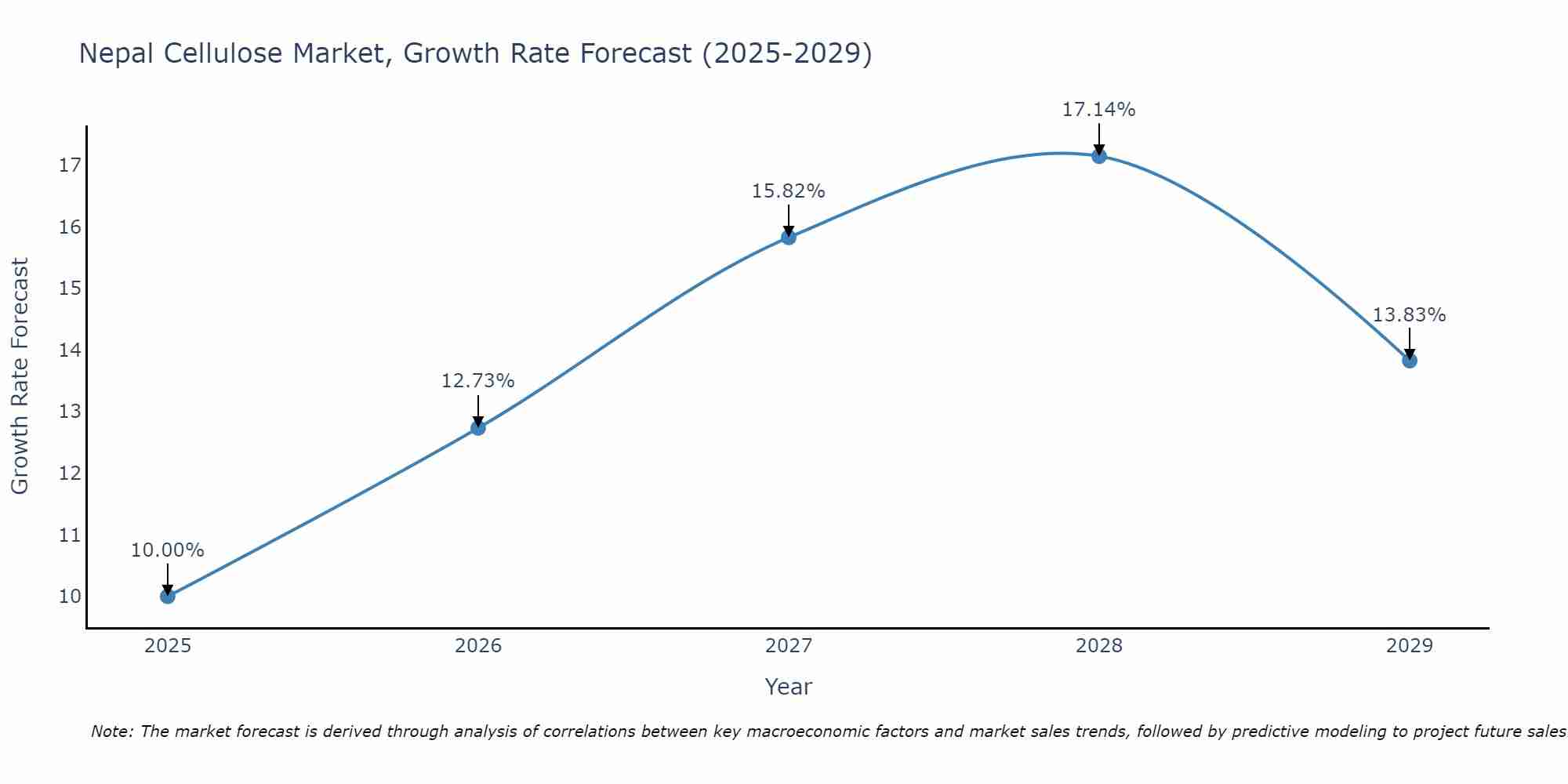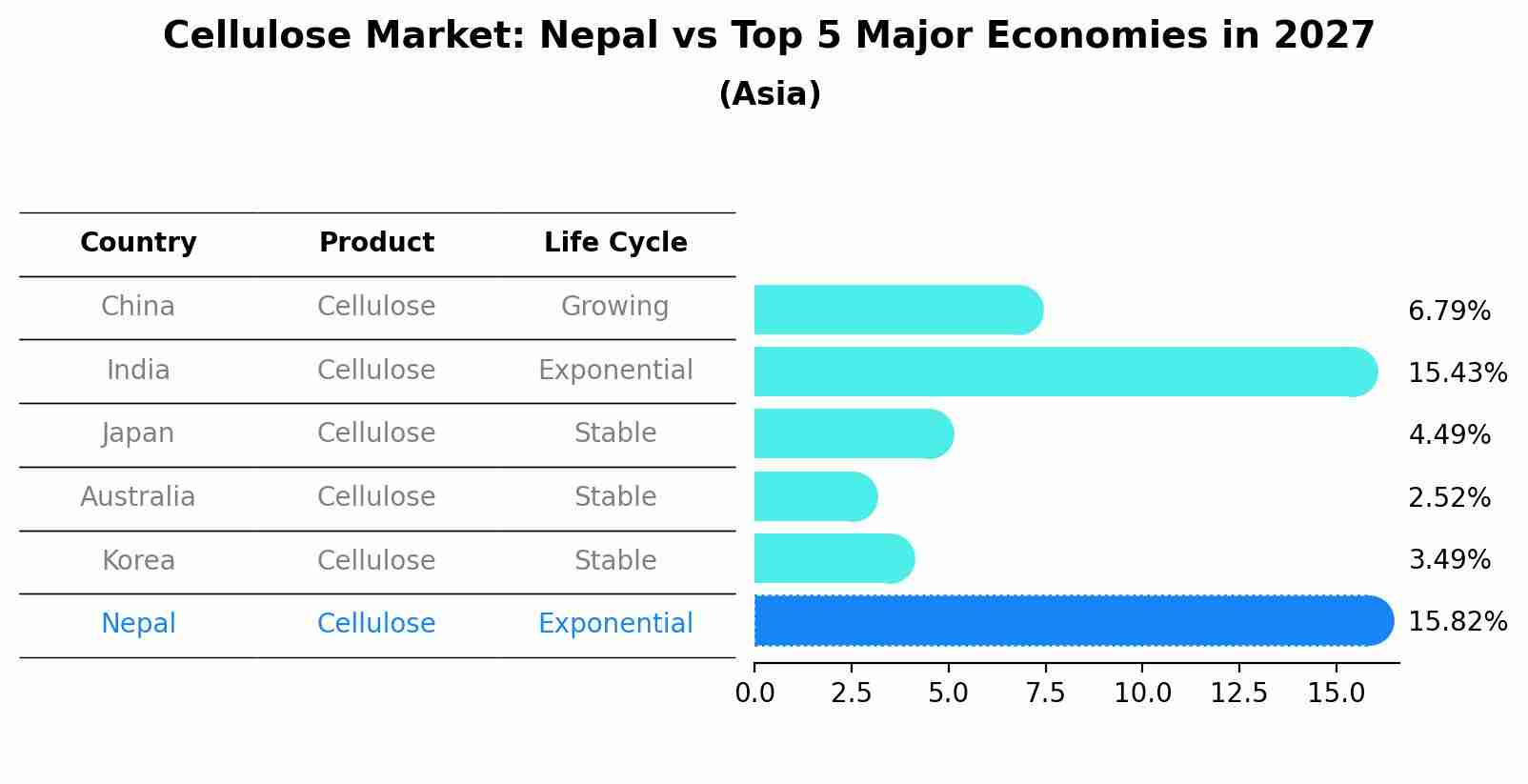Nepal Cellulose Market (2025-2031) Outlook | Size, Share, Industry, Forecast, Trends, Companies, Growth, Analysis, Revenue & Value
| Product Code: ETC073975 | Publication Date: Jun 2021 | Updated Date: Jun 2025 | Product Type: Report | |
| Publisher: 6Wresearch | Author: Sachin Kumar Rai | No. of Pages: 70 | No. of Figures: 35 | No. of Tables: 5 |
Nepal Cellulose Market Size Growth Rate
The Nepal Cellulose Market is projected to witness mixed growth rate patterns during 2025 to 2029. The growth rate begins at 10.00% in 2025, climbs to a high of 17.14% in 2028, and moderates to 13.83% by 2029.

Cellulose Market: Nepal vs Top 5 Major Economies in 2027 (Asia)
The Cellulose market in Nepal is projected to grow at a exponential growth rate of 15.82% by 2027, within the Asia region led by China, along with other countries like India, Japan, Australia and South Korea, collectively shaping a dynamic and evolving market environment driven by innovation and increasing adoption of emerging technologies.

Nepal Cellulose Market Overview
The Nepal cellulose market is experiencing steady growth driven by increasing demand for sustainable and eco-friendly products. The market is primarily dominated by products such as viscose fibers, wood pulp, and paper products. The growing awareness among consumers about the environmental impact of synthetic materials has led to a shift towards cellulose-based products. Additionally, the government`s initiatives to promote sustainable practices and investments in the forestry sector are also contributing to the market`s growth. The presence of key players in the industry, coupled with technological advancements in cellulose production, is further propelling the market forward. Overall, the Nepal cellulose market is poised for continued expansion as it aligns with global trends towards sustainability and green alternatives.
Nepal Cellulose Market Trends
The Nepal Cellulose Market is currently experiencing a shift towards sustainable and eco-friendly products. There is a growing demand for biodegradable cellulose-based materials, such as packaging solutions, textiles, and personal care products. Consumers are becoming more conscious of the environmental impact of traditional cellulose products and are seeking alternatives that are renewable and biodegradable. Additionally, technological advancements in cellulose production processes are driving innovation in the market, leading to the development of high-quality, sustainable products. Major players in the Nepal Cellulose Market are increasingly focusing on research and development to meet the growing demand for eco-friendly cellulose solutions, reflecting a broader global trend towards sustainability and environmental responsibility.
Nepal Cellulose Market Challenges
In the Nepal cellulose market, several challenges are faced, including inconsistent supply of raw materials due to dependency on imports, lack of advanced technology for processing cellulose products, limited awareness about the benefits of cellulose-based products among consumers, and stiff competition from synthetic alternatives. Additionally, inadequate infrastructure and transportation facilities can hamper the distribution of cellulose products to various regions in Nepal. The market also faces challenges related to regulatory policies and environmental concerns regarding the sustainable sourcing of raw materials. Overall, addressing these challenges will require investments in research and development, innovation in production processes, increased promotion of cellulose products, and collaboration among industry stakeholders to drive growth in the Nepal cellulose market.
Nepal Cellulose Market Investment Opportunities
Investment opportunities in the Nepal Cellulose Market include the growing demand for eco-friendly and sustainable products, driving the need for cellulose-based materials such as packaging, textiles, and pharmaceutical excipients. With Nepal`s abundant supply of natural resources like bamboo and agricultural waste, there is potential for the development of a robust cellulose industry in the country. Additionally, the increasing focus on reducing plastic usage and promoting biodegradable alternatives presents a favorable environment for investments in cellulose-based products. Investors can explore partnerships with local manufacturers, research and development initiatives for innovative uses of cellulose, or even setting up production facilities to cater to the domestic and international markets seeking sustainable solutions. Overall, the Nepal Cellulose Market offers promising opportunities for investors looking to capitalize on the global shift towards environmentally friendly products.
Nepal Cellulose Market Government Policy
The government of Nepal has implemented policies aimed at promoting sustainable practices in the cellulose market. These policies include regulations to prevent deforestation and promote the use of alternative sources of cellulose, such as agricultural residues and waste paper. Additionally, the government has introduced incentives for companies to invest in research and development of eco-friendly cellulose products. Import restrictions on non-sustainable cellulose products have also been enforced to protect the local market and encourage domestic production. Overall, the government`s policies in the Nepal cellulose market focus on environmental conservation, sustainable sourcing, and promoting innovation in the industry.
Nepal Cellulose Market Future Outlook
The future outlook for the Nepal Cellulose Market appears positive, driven by increasing demand for sustainable and eco-friendly products in various industries such as textiles, pharmaceuticals, and food & beverages. With a growing emphasis on environmental consciousness and the ban on single-use plastics, there is a rising interest in utilizing cellulose-based materials as alternatives. Furthermore, the government`s initiatives to promote the use of biodegradable products and investments in research and development for innovative cellulose applications are expected to further boost market growth. However, challenges such as high production costs and limited awareness among consumers may hinder the market`s full potential. Overall, the Nepal Cellulose Market is poised for expansion in the coming years, with opportunities for companies to capitalize on the growing trend towards sustainability.
Key Highlights of the Report:
- Nepal Cellulose Market Outlook
- Market Size of Nepal Cellulose Market, 2021
- Forecast of Nepal Cellulose Market, 2031
- Historical Data and Forecast of Nepal Cellulose Revenues & Volume for the Period 2021 - 2031
- Nepal Cellulose Market Trend Evolution
- Nepal Cellulose Market Drivers and Challenges
- Nepal Cellulose Price Trends
- Nepal Cellulose Porter's Five Forces
- Nepal Cellulose Industry Life Cycle
- Historical Data and Forecast of Nepal Cellulose Market Revenues & Volume By Fiber Type for the Period 2021 - 2031
- Historical Data and Forecast of Nepal Cellulose Market Revenues & Volume By Natural Cellulose Fibers for the Period 2021 - 2031
- Historical Data and Forecast of Nepal Cellulose Market Revenues & Volume By Man-made Cellulose Fibers for the Period 2021 - 2031
- Historical Data and Forecast of Nepal Cellulose Market Revenues & Volume By Applications for the Period 2021 - 2031
- Historical Data and Forecast of Nepal Cellulose Market Revenues & Volume By Apparel for the Period 2021 - 2031
- Historical Data and Forecast of Nepal Cellulose Market Revenues & Volume By Home Textile for the Period 2021 - 2031
- Historical Data and Forecast of Nepal Cellulose Market Revenues & Volume By Industrial for the Period 2021 - 2031
- Historical Data and Forecast of Nepal Cellulose Market Revenues & Volume By Others for the Period 2021 - 2031
- Nepal Cellulose Import Export Trade Statistics
- Market Opportunity Assessment By Fiber Type
- Market Opportunity Assessment By Applications
- Nepal Cellulose Top Companies Market Share
- Nepal Cellulose Competitive Benchmarking By Technical and Operational Parameters
- Nepal Cellulose Company Profiles
- Nepal Cellulose Key Strategic Recommendations
Frequently Asked Questions About the Market Study (FAQs):
1 Executive Summary |
2 Introduction |
2.1 Key Highlights of the Report |
2.2 Report Description |
2.3 Market Scope & Segmentation |
2.4 Research Methodology |
2.5 Assumptions |
3 Nepal Cellulose Market Overview |
3.1 Nepal Country Macro Economic Indicators |
3.2 Nepal Cellulose Market Revenues & Volume, 2021 & 2031F |
3.3 Nepal Cellulose Market - Industry Life Cycle |
3.4 Nepal Cellulose Market - Porter's Five Forces |
3.5 Nepal Cellulose Market Revenues & Volume Share, By Fiber Type, 2021 & 2031F |
3.6 Nepal Cellulose Market Revenues & Volume Share, By Applications, 2021 & 2031F |
4 Nepal Cellulose Market Dynamics |
4.1 Impact Analysis |
4.2 Market Drivers |
4.3 Market Restraints |
5 Nepal Cellulose Market Trends |
6 Nepal Cellulose Market, By Types |
6.1 Nepal Cellulose Market, By Fiber Type |
6.1.1 Overview and Analysis |
6.1.2 Nepal Cellulose Market Revenues & Volume, By Fiber Type, 2018 - 2027F |
6.1.3 Nepal Cellulose Market Revenues & Volume, By Natural Cellulose Fibers, 2018 - 2027F |
6.1.4 Nepal Cellulose Market Revenues & Volume, By Man-made Cellulose Fibers, 2018 - 2027F |
6.2 Nepal Cellulose Market, By Applications |
6.2.1 Overview and Analysis |
6.2.2 Nepal Cellulose Market Revenues & Volume, By Apparel, 2018 - 2027F |
6.2.3 Nepal Cellulose Market Revenues & Volume, By Home Textile, 2018 - 2027F |
6.2.4 Nepal Cellulose Market Revenues & Volume, By Industrial, 2018 - 2027F |
6.2.5 Nepal Cellulose Market Revenues & Volume, By Others, 2018 - 2027F |
7 Nepal Cellulose Market Import-Export Trade Statistics |
7.1 Nepal Cellulose Market Export to Major Countries |
7.2 Nepal Cellulose Market Imports from Major Countries |
8 Nepal Cellulose Market Key Performance Indicators |
9 Nepal Cellulose Market - Opportunity Assessment |
9.1 Nepal Cellulose Market Opportunity Assessment, By Fiber Type, 2021 & 2031F |
9.2 Nepal Cellulose Market Opportunity Assessment, By Applications, 2021 & 2031F |
10 Nepal Cellulose Market - Competitive Landscape |
10.1 Nepal Cellulose Market Revenue Share, By Companies, 2021 |
10.2 Nepal Cellulose Market Competitive Benchmarking, By Operating and Technical Parameters |
11 Company Profiles |
12 Recommendations |
13 Disclaimer |
- Single User License$ 1,995
- Department License$ 2,400
- Site License$ 3,120
- Global License$ 3,795
Search
Thought Leadership and Analyst Meet
Our Clients
Related Reports
- Germany Breakfast Food Market (2026-2032) | Industry, Share, Growth, Size, Companies, Value, Analysis, Revenue, Trends, Forecast & Outlook
- Australia Briquette Market (2025-2031) | Growth, Size, Revenue, Forecast, Analysis, Trends, Value, Share, Industry & Companies
- Vietnam System Integrator Market (2025-2031) | Size, Companies, Analysis, Industry, Value, Forecast, Growth, Trends, Revenue & Share
- ASEAN and Thailand Brain Health Supplements Market (2025-2031) | Strategy, Consumer Insights, Analysis, Investment Trends, Opportunities, Growth, Size, Share, Industry, Revenue, Segments, Value, Segmentation, Supply, Forecast, Restraints, Outlook, Competition, Drivers, Trends, Demand, Pricing Analysis, Competitive, Strategic Insights, Companies, Challenges
- ASEAN Bearings Market (2025-2031) | Strategy, Consumer Insights, Analysis, Investment Trends, Opportunities, Growth, Size, Share, Industry, Revenue, Segments, Value, Segmentation, Supply, Forecast, Restraints, Outlook, Competition, Drivers, Trends, Demand, Pricing Analysis, Competitive, Strategic Insights, Companies, Challenges
- Europe Flooring Market (2025-2031) | Outlook, Share, Industry, Trends, Forecast, Companies, Revenue, Size, Analysis, Growth & Value
- Saudi Arabia Manlift Market (2025-2031) | Outlook, Size, Growth, Trends, Companies, Industry, Revenue, Value, Share, Forecast & Analysis
- Uganda Excavator, Crane, and Wheel Loaders Market (2025-2031) | Strategy, Consumer Insights, Analysis, Investment Trends, Opportunities, Growth, Size, Share, Industry, Revenue, Segments, Value, Segmentation, Supply, Forecast, Restraints, Outlook, Competition, Drivers, Trends, Demand, Pricing Analysis, Competitive, Strategic Insights, Companies, Challenges
- Rwanda Excavator, Crane, and Wheel Loaders Market (2025-2031) | Strategy, Consumer Insights, Analysis, Investment Trends, Opportunities, Growth, Size, Share, Industry, Revenue, Segments, Value, Segmentation, Supply, Forecast, Restraints, Outlook, Competition, Drivers, Trends, Demand, Pricing Analysis, Competitive, Strategic Insights, Companies, Challenges
- Kenya Excavator, Crane, and Wheel Loaders Market (2025-2031) | Strategy, Consumer Insights, Analysis, Investment Trends, Opportunities, Growth, Size, Share, Industry, Revenue, Segments, Value, Segmentation, Supply, Forecast, Restraints, Outlook, Competition, Drivers, Trends, Demand, Pricing Analysis, Competitive, Strategic Insights, Companies, Challenges
Industry Events and Analyst Meet
Whitepaper
- Middle East & Africa Commercial Security Market Click here to view more.
- Middle East & Africa Fire Safety Systems & Equipment Market Click here to view more.
- GCC Drone Market Click here to view more.
- Middle East Lighting Fixture Market Click here to view more.
- GCC Physical & Perimeter Security Market Click here to view more.
6WResearch In News
- Doha a strategic location for EV manufacturing hub: IPA Qatar
- Demand for luxury TVs surging in the GCC, says Samsung
- Empowering Growth: The Thriving Journey of Bangladesh’s Cable Industry
- Demand for luxury TVs surging in the GCC, says Samsung
- Video call with a traditional healer? Once unthinkable, it’s now common in South Africa
- Intelligent Buildings To Smooth GCC’s Path To Net Zero


















